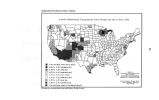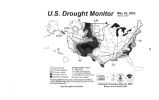| OCR Text |
Show 32 mountains, so you need a fair number of places where it's measured to get an adequate representation of what's going on. REMOTE DROUGHT- SENSING TECHNOLOGIES Mr. CANNON. DO you have any idea if there's any kind of remote sensing technology, whether it be the color of some kinds of plants might be indicative of the amount of moisture in different depths of soil? Is that going on so that we can reduce our costs of gathering that data? Dr. POTTER. Yes, it's going on. NASA regularly does this and some of the operational Federal agencies also are involved in it, I believe the USDA and others are making maps, satellite maps of greenness indicators and they readily show across places as large as the whole United States, or across all of Africa, very clear indications of when the plants are being stressed and, hence, when drought is around. Mr. EUBANK. That's primarily though the root zone. And this soil moisture that sucks the snow into the deep earth is at 20 inches or lower. Mr. CANNON. That's why I asked. Are you focusing on some different kinds of- I take it you have deeper roots on different kinds of plants that might tell us real good answers. Mr. EUBANK. I don't know the answer to that. Mr. CANNON. A lot of these things possibly are in planning. I would love to see that kind of technology developed where we could get more data for less money. PALEO CLIMATE DATA Dr. Potter, you talked about paleo data about 10,000 years. Can you give us a little more information about how much of this information is available by region in America and around the country based on paleo data. Dr. POTTER. Yes. I'm certainly not an expert. Perhaps our colleague, Mike Hayes, probably can answer more, but there's a lot of data around from different sources, different groups, and mostly university groups, working on this paleo climate data and there are, in addition to the ones that I mentioned, there's ice core data from Greenland and from Antarctica that show some of it back tens and hundreds of thousands of years ago. So there's a fair amount of data available. The triggering data is really enough so that they can tell what the drought is year- by- year back for several hundred years to even thousands of years. Some of the bristlecone pine trees are 4,000 years old and by looking at them very carefully they can tell what the drought conditions and temperature conditions are every one of those years. Mr. CANNON. And you do that, say, in Arizona where they've got bristlecone pines that've sat for a thousand years or more. Do you have any sense of how much this is done worldwide and whether there's a pool of data? Dr. POTTER. I think there is a fair worldwide thing. I know that within Europe there are many centers looking at various aspects of ice cores and tree rings and other paleo data. |


























































































